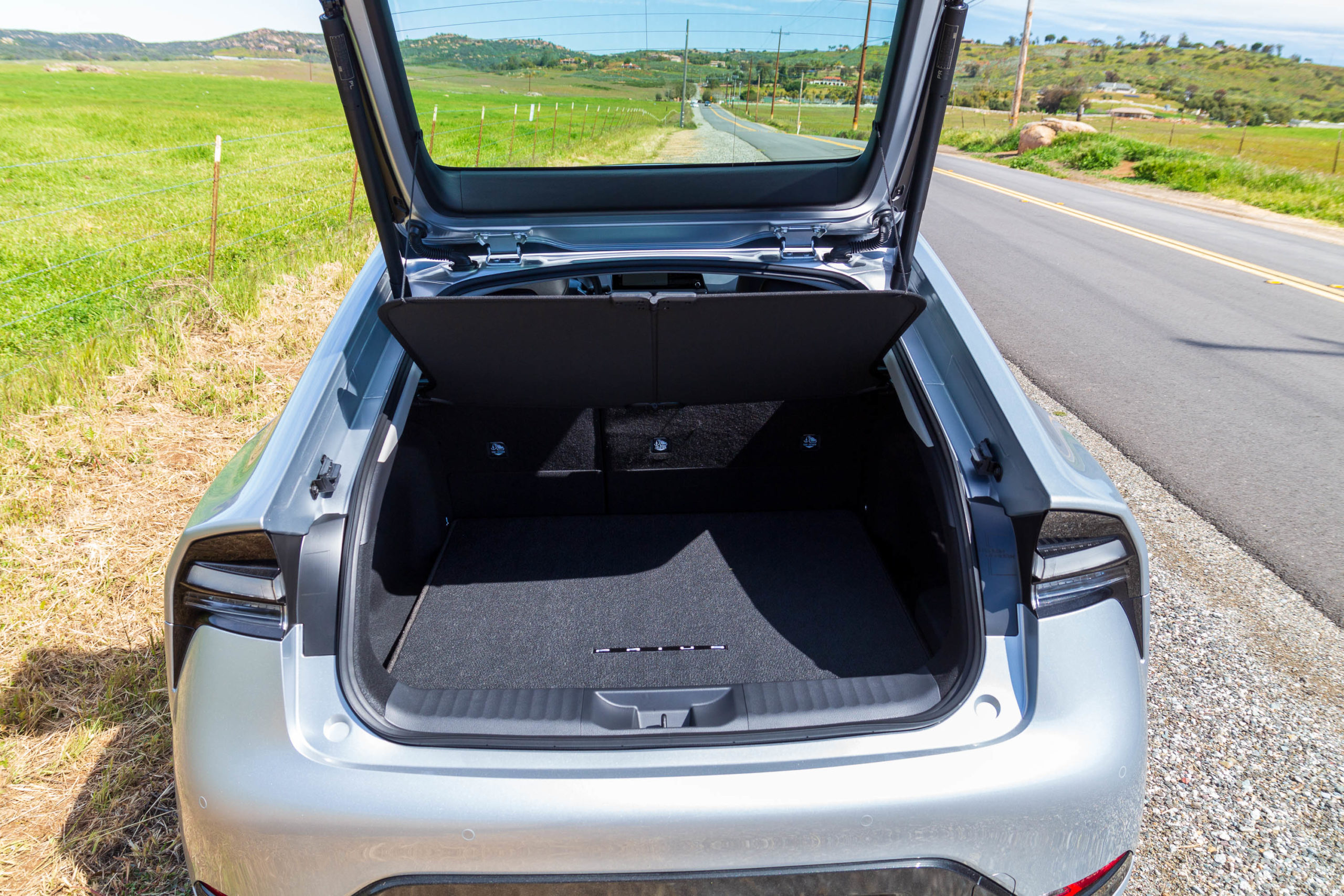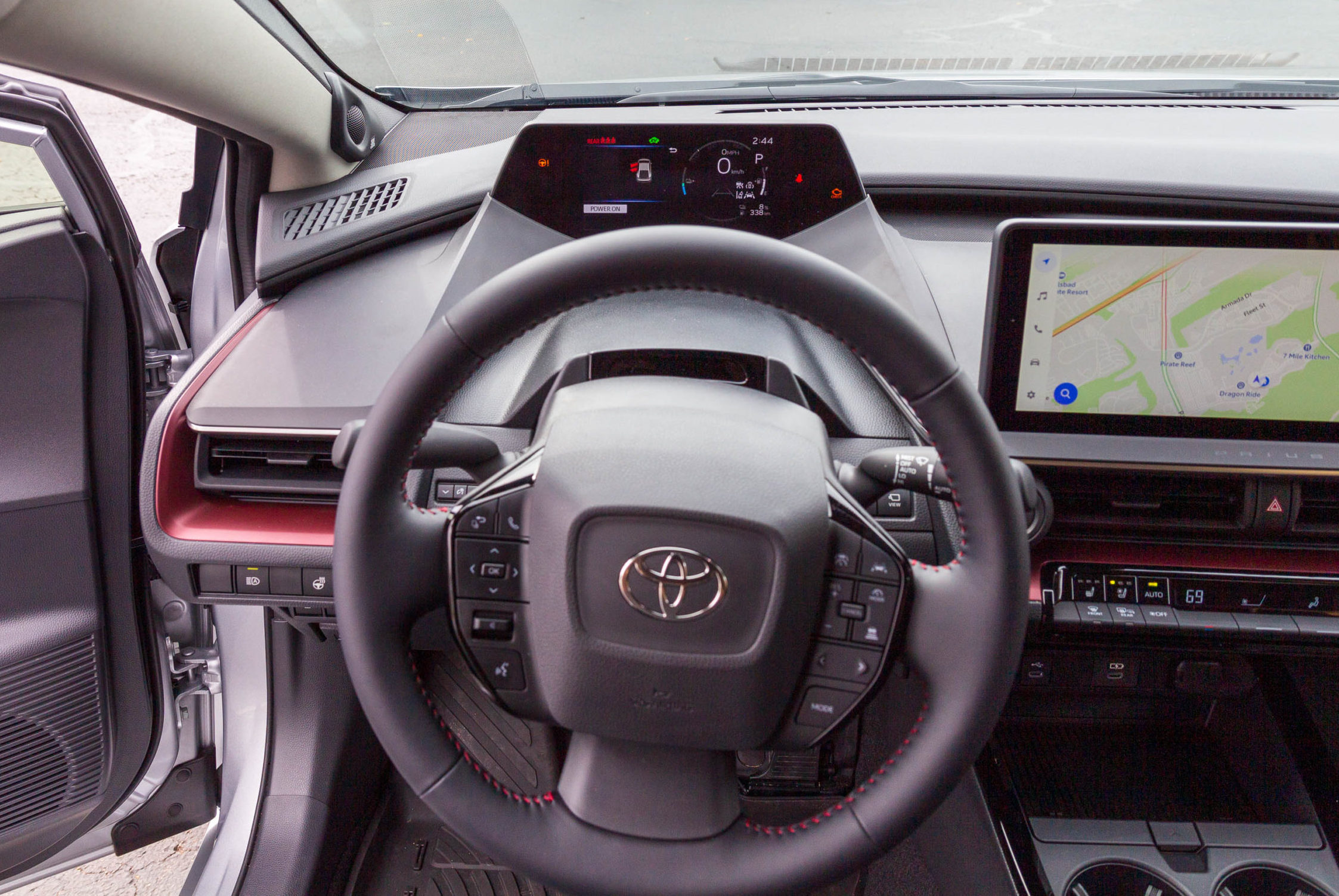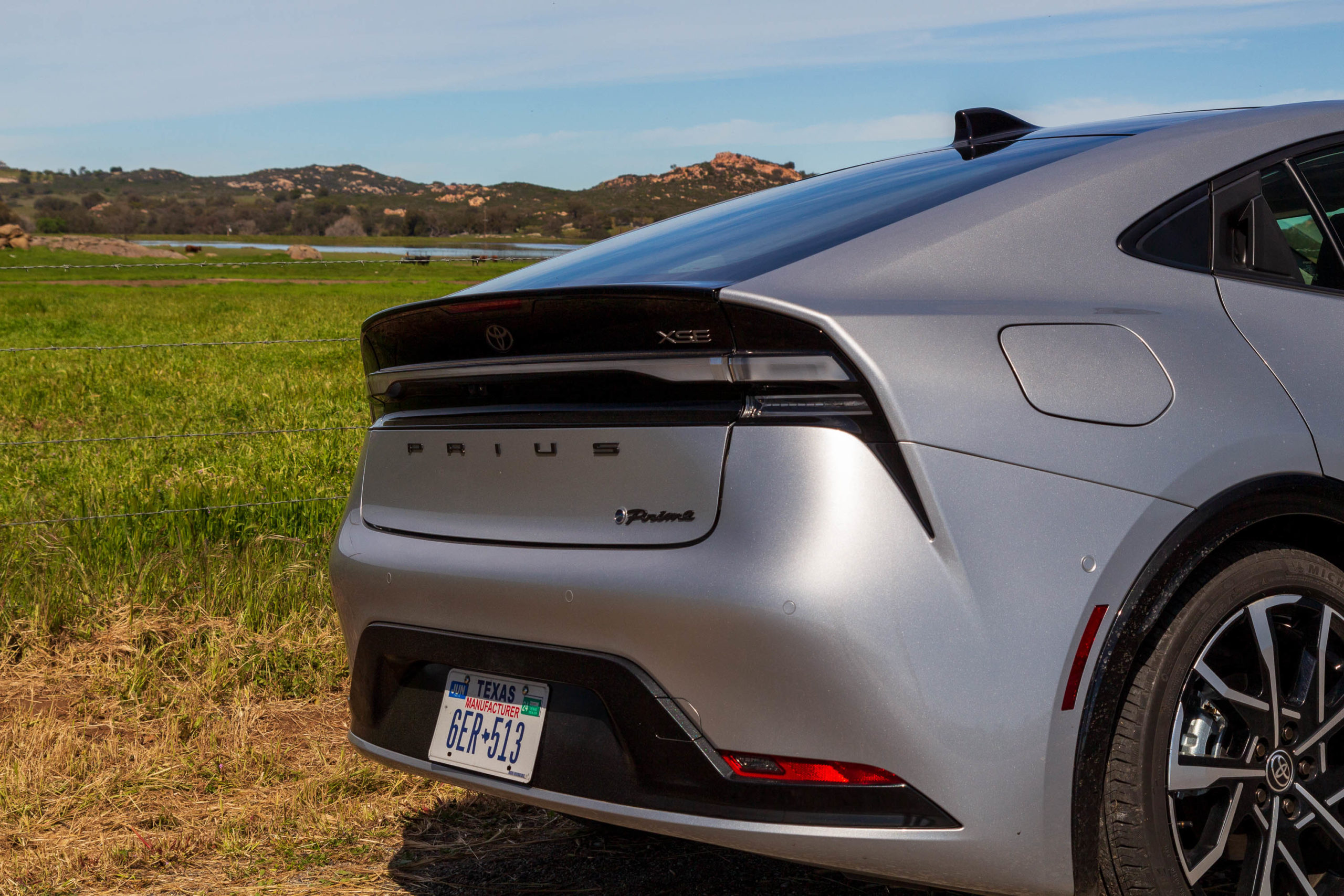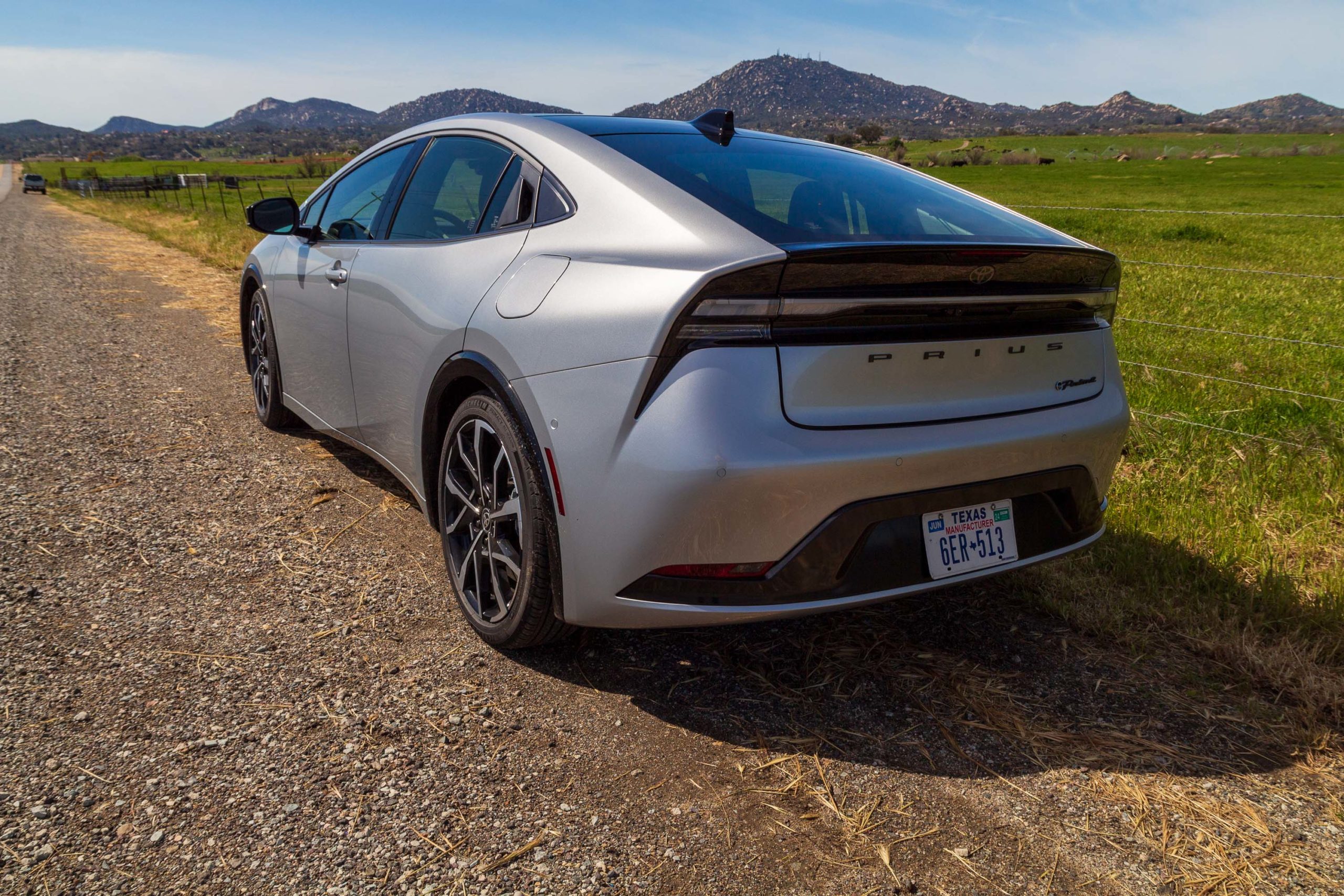The 2023 Toyota Prius was suddenly hot. The oddball that sipped fuel got a glow-up and turned into one of the sharpest-looking models on the road. At the car’s first media drive, every time I stopped for photos somebody wanted to know what the car was.
Look under that sleek sheet metal and the Prius is finally fun. For the first time, this is a car that doesn’t feel like a slug. Instead, it felt more like you were driving the high-tech version of a vintage Paseo.
So, what did Toyota have in store for the plug-in hybrid (PHEV) version of the fully updated Prius?
In short: For the 2023 Toyota Prius Prime, the suddenly stylish model gets more range and more power. It is now something you’d be happy to have in your driveway, not the solely pragmatic choice it once was.
-
Powertrain
2.0L inline 4-cylinder plus electric motor -
HP
220 hp combined -
MPG
SE 53 city/51 highway/52 combined mpg, XSE 50/47/48 mpg -
Electric range
SE 44 mi., XSE 39 mi. -
Cargo capacity
20.3 cu. ft.
-
Great looks -
Highway-grade electric power -
Advanced driver assists -
44 miles of electric range -
Impressive fuel economy (over 50 mpg)
-
No all-wheel drive -
Tiny trunk -
Lack of headroom -
Cramped rear cabin -
Best ADAS features cost monthly
2023 Prius Prime Delivers More
More power, more range, more miles per gallon.
A new 2.0L four-cylinder engine and a new electric motor each make more power than the last-gen Prius Prime. The total is nearly 100 more horses.
The four-cylinder’s 150 horsepower and 160 horsepower from the electric motor give the Prius Prime a total of 220 peak horsepower. No, that doesn’t math, but the gas and electric powerplants don’t both make their max power at the same time, so it all does add up.
Substantially more power makes the Prius much more responsive. It’s better for highway merging, passing, and zipping around town. It’s even more fun when you’re on a twisty road.
Crucially, the extra electric power lets you spend more time in electric mode. Prime now has no trouble on the highway in EV mode. The motor lets you stay in electric mode at speeds up to 84 miles per hour, and Prime is no longer lethargic on the way there, helping you use less fuel.
More Battery Power, More Electric Range
Prime’s battery has added capacity too. It holds 13.6 kWh of energy, up from 8.1 kWh in the outgoing Prime. The capacity upgrade comes with 75% more electric range.
This 75% more gives the Prime an estimated 44 miles of range. That’s for the SE, at least. Getting the XSE or XSE Premium trims adds larger 19-inch wheels and drags range down to an EPA-estimated 39 miles.
The end result of all of this extra power isn’t just a car that’s quicker — and a bit more fun. It’s a car that doesn’t give up much in the way of fuel economy.
On the combined test cycle, the 2023 Toyota Prius Prime gets an estimated 52 miles per gallon — 48 for XSE and XSE Premium. That’s two fewer than the older, slower Prime. In the real world, though, it should use significantly less fuel because it can go so much farther without gas thanks to all of that extra EV range.
Plug the Prius Prime into the wall and it’ll take about 11 hours to fully charge. The Prime can handle Level 3 fast charging as well, with a 3.5kW max speed topping up the battery in around 4 hours. Of course, you don’t ever need to plug it in, as it’s a PHEV, though that defeats the whole point of this car.

No All-Wheel Drive for Prime
Prius offers all-wheel drive thanks to a small electric motor mounted to the rear axle. Prius Prime is front-drive only. There’s not enough room back there for the big battery, a gas tank, and all of the gear that goes with the extra motor. If you want your Toyota with all-wheel drive, an engine, and a plug, you’ll need to step up to the larger RAV4 Prime.
Upsizing would be a shame because the Prius Prime is a much better car than its larger sibling. Along with the stylish new metal, Toyota made the Prius much nicer inside than any prior Prius. Next to the Corolla Cross, the other model I drove on this event, the Prius Prime feels like a Lexus.
Same Small Cargo Space as Non-PHEV

On the other hand, there’s one other reason you might want to upgrade to the RAV4, and that’s cargo space. Despite the hatchback rear (there’s even an available power hatch), Prime holds just 20.3 cubic feet of whatever you want to put back there with the rear seats in place.
Fold the rear seats and space grows marginally — by just 6.4 cubes.
It’s a small hatch. The low glass line means that the space is wide and long, but it isn’t tall. Put anything larger than a duffel bag in the back, and it’s going to come into conflict with the cargo cover and then the glass.
No More Center Cluster

After generations of an oddball center instrument cluster, Toyota has moved the gauges back in front of the driver. But they’re mounted much higher than is normal and set back closer to the windshield.
This gauge cluster layout leaves a strange empty space between the steering wheel and the screen. But the high and far location is closer to your natural focus points when you’re driving. You don’t need to move your eyes as far down to look at the dash. This allows you to spend more time watching where you’re going. So, much like the Prius Prime as a whole, it’s unusual but effective.
The center screen is in the normal location, sitting much closer to the driver and passenger. SE grade Primes get a small 8.0-inch screen, but XSE and up get a bigger 12.3-inch unit.
All screens big and small get the same Toyota multimedia interface. The same system Toyota launched with the latest Tundra and is quickly putting in every one of its vehicles.

The system is fast and responsive. The hardware behind the screen does its job impressively quickly. The upgrade from the last-gen Toyota infotainment system to this one is a massive leap, and one that was long overdue.
This infotainment interface is loaded with clever voice controls. Natural speech requests can change functions and tune the radio. If the speech request can’t do it, it will take you to the right page so you can make the change quickly yourself.
The trick, as with most of these systems, is to avoid trying to overthink. Don’t ask a complicated question; just say you’re cold. Or ask for your favorite radio station.

Safety Features a Toyota Priority
Toyota always goes all-in on safety, and the Prius Prime is no different. Toyota Safety Sense 3.0 is standard and includes the usual collision avoidance and radar cruise features. Blind spot monitoring is also included on all trim levels. Version 3.0 has more features than 2.0 or 2.5. It also has longer-range sensing thanks to hardware and software improvements.
There are some new features, too. Proactive Driving Assist is new and it will gently brake into curves or help steer to make sure you avoid cyclists or pedestrians. Lane Change Assist does some of the steering when you’re changing lanes.
There is also the available Advanced Park system that can help you park in a parallel or perpendicular space. Another system can stop the vehicle safely if it detects an unresponsive driver.

Hands-Free Traffic Jams
If you live anywhere where traffic is a problem, Traffic Jam Assist is worth your attention. It works at speeds up to 25 miles per hour, maintaining the distance to the car in front of you and staying centered in the lane.
The low-speed system works hands-free, though it does watch to make sure you’re watching the road and not your phone.
Traffic Jam Assist is a subscription feature and is offered on all grades of Prius Prime. Any Primes with the 12.3-inch screen comes with a one-year Drive Connect subscription. You’ll need to pay after that. For models with the 8.0-inch screen, you’ll need to pay for a Drive Connect subscription from the start. As of this writing, Drive Connect is $15 per month.
There are some other clever safety features, too, like the red LED light strip in that anodized-look red trim around the dash. The red lights are on as ambient lighting in the dark but have a second function.
When traffic ahead of you pulls away from a stop, the strip will flash. A little heads-up if you’re on your phone. The same strip will flash to warn you that the active assists are detecting a problem (they’ll also beep). Handy if you’re looking down instead of up at the road ahead.
Or, of course, you could just put your phone down when behind the wheel.
The experience behind the wheel is not what you expect from a Prius, but that is just, to steal a phrase, the new normal.

Prime Offers Comfortable, Drama-Free Drive
Prius Prime is now, dare we say it, fun. Not the kind of fun that you’d get from a sports sedan — this is no Gazoo Racing model — but the fun that makes drives more enjoyable. A smooth ride combines with wonderfully direct steering to make this a vehicle that just gets on about the task at hand. Whether that’s a twisty road or a concrete freeway, the 2023 Prius Prime doesn’t care.
Heave and roll are well controlled, but there’s no sense of stiffness in the suspension — much like how the steering is quite enjoyable but has zero road feel and a load of power assist. This is Toyota as a high-quality appliance. Clever design and excellent ergonomics rule the day, though this one does have some fancy sheet metal wrapped around it.

2023 Prius Prime: 3 Trim Offerings
Toyota is launching three trims of Prius Prime: SE, XSE, and XSE Premium.
Base SE comes with most of the goodies you want — rain-sensing wipers, a heated leather wheel, six USB-C ports, and both wireless Apple CarPlay and Android Auto.
Strangely, though, it has a heated wheel, but you’ll need to step up to XSE for heated front seats. On that trim, they’re also finished in Softex fake leather instead of fabric, and the driver seat has power adjustment.
Along with the heated seats, you get 19-inch wheels, cup holders for the rear, and front and rear park assist. An option pack on XSE adds the 12.3-inch screen, nonopening dual sunroofs, and the ability to use your smartphone instead of a key fob for access and start.
The top XSE Premium gets the bigger screen, power hatch, and vented front seats. You’ll need to add another package on top to get the digital rearview mirror, advanced park self-parking, and heated rear seats.
2023 Toyota Prius Prime Review: Summary

The Toyota Prius Prime has offered a strong value proposition since it was introduced back in 2012. The PHEV was one of the first on the market and delivered lots of Prius weirdness and an almost alarming ability to save fuel, augmented with a range of just 6 miles. It couldn’t even hit highway speeds on electric power.
Today’s Prius Prime delivers even better fuel economy, more than seven times the range, and has nearly 100 more horsepower. It can also break the speed limit on nearly every highway in the country. Better yet, the 2023 Prius Prime can do all of those things without being too much of an oddball.

The Prius Prime is no longer a car you buy solely for efficiency. It’s a car you buy because it looks good and drives well, which just happens to be one of the most efficient vehicles on the road.
